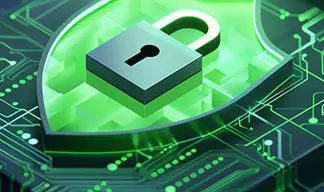With cybercriminals becoming increasingly sophisticated in their attacks, staying ahead of emerging threats is not just a good practice—it's essential for the survival of businesses. Here are some of the top cybersecurity risks for businesses today and practical steps you can take to mitigate them.
The cybersecurity landscape is constantly evolving, with cybercriminals becoming increasingly sophisticated in their attacks. For businesses, this means staying ahead of emerging threats is not just a good practice—it's essential for survival. Here are some of the top cybersecurity risks for businesses today and practical steps you can take to mitigate them.
1. AI-Driven Cyber Attacks
Artificial intelligence is revolutionizing industries, but it's also arming cybercriminals with powerful tools for launching sophisticated attacks. AI can be used to automate phishing campaigns, crack passwords, or even identify vulnerabilities in networks faster than traditional methods.
Mitigation Strategies:
- AI-Powered Defenses: Just as attackers are using AI, businesses should also leverage AI, ML, and copilots to detect anomalies, automate threat responses, and improve overall security.
- Employee Awareness: Train employees on the risks of AI-powered phishing and social engineering attacks, which may be more convincing and harder to detect than traditional methods.
- Learn more from our Security expert about AI Preparations for CISOs.
2. Supply Chain Attacks
Supply chain attacks continue to rise, where attackers target vulnerabilities in third-party vendors or partners to compromise larger organizations. These indirect attacks are often harder to detect and can have wide-reaching consequences.
Mitigation Strategies:
- Vendor Risk Management: Perform thorough security assessments of all vendors and partners. Ensure they adhere to your cybersecurity standards and include clauses in contracts that mandate regular security audits.
- Zero Trust Approach: Implement a Zero Trust architecture, which assumes no user or device, internal or external, can be trusted by default. Regularly monitor and limit access to critical systems.
- Learn more about Valorem Reply’s Zero Trust Security Foundation.
3. Ransomware as a Service (RaaS)
Ransomware attacks have grown in both frequency and severity, and with the rise of "Ransomware as a Service" (RaaS), even less-skilled cybercriminals can launch devastating attacks. These attacks can halt business operations, compromise data, and lead to significant financial losses.
Mitigation Strategies:
- Backup and Disaster Recovery Plans: Regularly back up all critical data and ensure that backups are stored offline and can’t be accessed by ransomware. Test your disaster recovery plan to ensure quick restoration of systems in case of an attack.
- Endpoint Protection: Use advanced endpoint detection and response (EDR) tools to detect ransomware early and isolate affected devices.
- Learn more about our Free Cybersecurity Product Demos.
4. Cloud Security Misconfigurations
As more businesses move to the cloud, the risk of security breaches due to misconfigurations continues to grow. Misconfigured cloud services can expose sensitive data, making them prime targets for attackers.
Mitigation Strategies:
- Automated Security Tools: Use automated tools to scan your cloud infrastructure for misconfigurations and vulnerabilities. These tools can alert your security teams to any issues in real-time.
- Cloud Security Training: Ensure your IT team is trained in cloud security best practices, including securing APIs, using strong access controls, and enabling multi-factor authentication (MFA).
- Learn more about Valorem Reply’s Cloud Security Assessment.
5. Social Engineering Attacks
While technology evolves, cybercriminals continue to rely on social engineering tactics to manipulate employees into giving away sensitive information or access to systems. These attacks can take many forms, including phishing emails, phone calls, or even in-person attempts.
Mitigation Strategies:
- Ongoing Employee Training: Conduct regular, updated cybersecurity training sessions to keep employees aware of the latest social engineering tactics. Phishing simulations can help employees practice identifying suspicious communications.
- Multi-Factor Authentication (MFA): Implement MFA across all systems and accounts to provide an additional layer of protection, even if credentials are compromised.
- Learn more from our Security expert about Identity and Access Management.
6. IoT (Internet of Things) Vulnerabilities
The growing number of IoT devices in the workplace offers new attack surfaces for cybercriminals. Many IoT devices lack robust security features, making them easy entry points for attackers.
Mitigation Strategies:
- Network Segmentation: Isolate IoT devices on a separate network from critical systems. This ensures that even if a device is compromised, attackers cannot access sensitive data or other parts of the network.
- Regular Patching and Updates: Keep all IoT devices updated with the latest security patches. Where possible, disable unnecessary features that could expose vulnerabilities.
- Learn more about Valorem Reply’s Network Security Assessment.
7. Insider Threats
Whether intentional or accidental, insider threats remain a significant risk for businesses. These can range from disgruntled employees leaking sensitive information to well-meaning staff who unintentionally compromise security.
Mitigation Strategies:
- Access Control Policies: Implement strict access control policies, ensuring that employees only have access to the information they need to perform their jobs.
- Behavior Monitoring: Use behavior monitoring tools to detect suspicious activity within your network. Early detection of abnormal behavior can prevent insider threats before they escalate.
- Learn more about our Microsoft-Funded Cybersecurity Workshops.
Conclusion: Proactive Cybersecurity for the Modern Enterprise
The cybersecurity risks businesses face today are more complex than ever. As technology advances, so do the methods used by cybercriminals. By understanding these risks and implementing proactive measures—such as AI-powered defenses, Zero Trust architectures, and rigorous employee training—your organization can stay ahead of evolving threats and safeguard its critical assets.
At the core of any cybersecurity strategy, it’s crucial to maintain strong security hygiene practices. This includes regular patch management, implementing multi-factor authentication (MFA), ongoing user education, and enterprise access management. These foundational measures are key to reducing vulnerabilities and fortifying your organization’s defenses against both new and evolving cyber threats.
Cybersecurity is no longer a set-it-and-forget-it endeavor; it's an ongoing effort that requires vigilance, adaptability, and constant improvement. By taking the right steps now, businesses can reduce their exposure to these risks and ensure a more secure future. Contact us today to take the next step in securing your enterprise!







